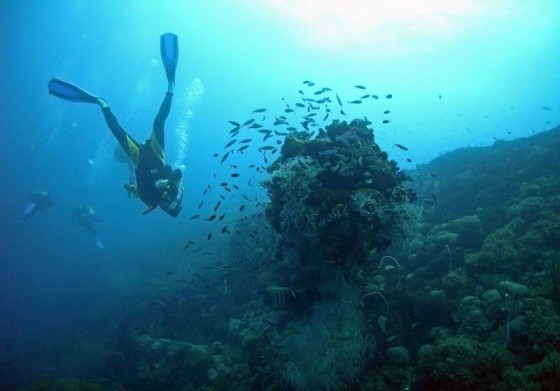
Great Barrier Reef Australia is one of the finest natural gifts to the marine diversity of this world. For us it may be the association of fun, frolic, and scuba diving but for scientists and nature lovers of the world it is a place that must be saved and preserved at all costs. This region has over 2,900 reefs, around 940 islands and cays. The area sprawls around for 2,300 kms in the Queensland Coast. The Marine park is 345,000 km.Atlleast 1,500 species of fish, 359 types of hard coral and 175 avian species have been recorded here. The reef has atleast 5,000 to 8,000 molluscs along with a wide variety of sponges, worms, crustaceans. The reef is frequented by tourists and scuba divers from world over. It is easily accessible from Cairns. You can also take a boat trip here that is conducted from Queensland coast and is reasonably priced. Several of the coral cay islands have been transformed into resorts were tourists can also stay over if it takes their fancy.
Till 1996 Great Barrier Reef Australia was more of a domestic location attracting nearby holidaymakers. However its beauty spread worldwide and now you will hardly get rooms during the peak season. You can take a ride in the reef with the dinghies and also in superyacht. Glass bottom boats are ideal for those who want to take a sneak peep into the coral reef below. The coral polyps below give an exquisite coloration to the water near the reef. Great Barrier Reef Marine Park acts as a natural guardian to the reef while limiting fishing and coral smuggling activities here. Even tourism here is limited as it might harm the marine population. The Great Barrier Reef includes the Murray Islands. It stretches from Torres Strait in North to an unnamed passage in middle to Fraser Island in the South.

Vegetation and marine population in Great Barrier Reef Australia
This area has some of the rarest of marine species that exists on the Earth today. Green sea turtlehas been reported here. Thirty specimens of whales, dolphins, and porpoise can be seen here. The rare dwarf minke whale, Indo-Pacific humpback dolphin can be seen here as well. A wide variety of turtles has made it their home namely Olive Ridley, leatherback sea turtle, hawksbill turtle, loggerhead sea turtle, flatback turtle. For some of these species it is a breeding ground like the Olive Ridleys and the Flatback. It is an interesting fact that the Olive Ridley swims through half the world to breed here and another half to lay their eggs. Crocodiles can be found near the swampy are of the reef.
Mix and match your trips here. For instance make a day trip to the Great Barrier Reef in the first half of the day and later make way straight to the Green Island. This is atleast 6000 year old and is in close proximity to the Reef. You can rest in the pontoon and unpack your picnic hamper. There are also buffet arrangements here. A sun deck, swimming enclosure for children and changing rooms are available here. If you think that cruising doesn’t exactly give the open air feel you can always take a ride in the Santa Maria and see the many wonders of the reef. The sea urchins underwater are a beautiful site. They use both blood and water for energy circulation. They feed on algae. It is best not to touch them when you are going underwater.

While scuba diving in the Great Barrier Reef Australia there are a few things to remember that can stand you in good stead.Always ask the guide questions and tell them to show you around and ask for suggestions. Relax even if you feel it’s a whole new world and shark can come in attack any moment. No your guide would know so just relax as this way you can breath slowly and can stay in the water longer. Do not at anytime disturb the natural habitat of the marine life. You are not allowed to feed the fish as that might disturb the natural eco system of the marine life. Don’t break corals just because they are rare and colorful. Remember it takes millions of years to form a tiny portion of it. If any official catches you with it, the penalty will not be worth the temptation. Trust on that.